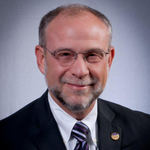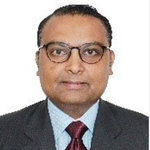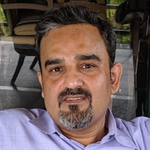- Welcome Address
Emily Cheah - SESSION 1: Regulatory Landscape and Trends
Dinesh Khokal - Sterile Drug Products: Microbiological Contamination Risk Considerations
Rick FriedmanThis presentation will cover some current microbiological hazards relating to sterile drugs, with emphasis on aseptic processing issues. It will also discuss the role of robust manufacturing equipment design and vigilant quality risk management in assuring reliable sterile drug production. The presentation will emphasize strong supplier controls, including lifecycle management and quality assurance. It will also note that the knowledge of the body of the literature and current research findings provide important inputs to the risk management decisions. Finally the presentation will emphasize the value of leveraging of modern, highly capable technologies.
- Updates on Regulatory Inspections in Singapore
Jessica Teo - Panel Discussion and Q&A
Rick Friedman•Dinesh Khokal•Jessica TeoModerator: Dinesh Khokal
Panelists: Rick Friedman and Jessica Teo - Closing Remarks by the Moderator
Dinesh Khokal - Networking Demo Session by OpTek Systems: Positive Controls for Container Closure Integrity Testing, an Integrated Approach and Recent Advancements
Presenter: Chris Randon, Head of Micromachining
- SESSION 2
Eoin Hanley - Premise Behind the Revision to Annex 1
Tracy Moore - Quality Risk Management, an Update on the Ongoing Revision of ICH Q9
Kevin O'DonnellThis presentation will discuss the ongoing revision of ICH Q9 on Quality Risk Management. It will address the key topics being addressed in the revision - Subjectivity in QRM, Product Availability Risks, Formality in QRM, Risk-based Decision Making, Risk Review and Hazard Identification. The presentation will discuss why each of the aforementioned topics are being addressed, and it will highlight how the revision work is taking into account the guidance in ICH Q10 in relation to ‘science and risk based decisions’ – which emphasises the link between QRM and KM as a means to making such decisions. (A significant part of the ongoing Q9 revision is about decision making and the use of science and knowledge to facilitate that.)
- Implementing the Contamination Control Strategy
Di Morris - Panel Discussion and Q&A
Eoin Hanley•Dinesh Khokal•Tracy Moore•Di Morris•Kevin O'DonnellModerator: Eoin Hanley
Panelists: Tracy Moore, Kevin O’Donnell and Di Morris
Eoin Hanley
Associate Director of CSL Behring
Dinesh Khokal
Director, External Affairs, JAPAC and Intercontinental - LatAm of Amgen
Tracy Moore
Expert GMDP Inspector at Medicines and Healthcare products Regulatory Agency (MHRA)
Di Morris
Clinical Auditor at AstraZeneca
Kevin O'Donnell
Market Compliance Manager at Health Products Regulatory Authority
- SESSION 3: Aseptic Processing Challenges in the Context of Annex 1
Lisa Bennett•Bruce LoxleyOpening Remarks by the Moderators
The inclusion of PUPSIT in Annex 1 have challenged operations with regards to wording and interpretation; particularly with regards to when and why a risk assessment should be used. - The implications of PUPSIT in Annex 1 revision
Hal BasemanPre-use, post sterilization integrity testing (PUPSIT) is a requirement in the current and the draft revision versions of Annex 1 for companies using filtration to sterilize sterile biopharmaceutical products. It is in place primarily to address a risk to sterile product posed by filter integrity failures that allow for the passage of microorganisms during the filtration process, and are later masked by product, so the failures are not detected by end of use integrity testing. However, the PUPSIT procedure requires access to the downstream side of the sterilized filter assembly and sterile product transfer lines. However, the PUPSIT procedure requires access to the downstream side of the sterilized filter assembly and sterile product transfer lines. This and the complex control systems needed to perform PUPSIT add a level of contamination risk to the aseptic process. Over the years, the existence and probability of the masking phenomenon and the relative risk of PUPSIT have been debated by filter manufacturers, industry, and regulators. The PDA in collaboration with the Biophorum Group conducted research into sterile filtration quality risk management (SFQRM) that impacts the PUPSIT related questions. The modified PUPSIT language in the current draft version of Annex 1, in part, reflect the outcome of those efforts. The most recent Annex 1 draft language allows for some risk based decisions on PUPSIT under defined conditions, with restrictions and limitations. This presentation will discuss the intent and use of PUPSIT requirement as noted in the current draft, its impact with and on other sections of the draft Annex, the current state of SFQRM research, and possible PUPSIT strategies.
- Sterile Filtration Quality Risk Management Collaboration and PUPSIT Failure Survey
Marjo PetersIn December 2017 the PDA and BioPhorum came together and formed the SFQRM consortium (Sterile Filtration Quality Risk Management) to respond to specific needs from regulators and end-users to determine when and why a risk assessment would require the use of the Pre-Use/Post-Sterilization Integrity Testing (PUPSIT) for sterilizing grade filters. The main concern was voiced in a Q&A document of 2007, which mentioned the potential of filter flaw masking, which would mean a flaw is not detected with the post-use integrity test. This concern raised, started the sporadic enforcement of the implementation of PUPSIT, respectively the urgent need to determine whether there is such masking propensity. Moreover, the risk of masking, filter handling, transportation etc also had to be weighed against the risk of a PUPSIT implementation since it is adding significant complexity and therefore risk to the sterility assurance of the process. This meant science-based tests and evaluations had to be performed to create a solid data base for such appropriate risk assessment.
To better understand the use of PUPSIT, the SFQRM consortium issued the PUPSIT failure survey to provide a clear and well evidenced argument with data that reflects the reality of implementing PUPSIT and the impact it has on time, costs, and effort. The PUPSIT failure survey was completed by the consortium member companies in 2017, 2019, and again in 2021. The questions in the survey are around media fill, sterility and other failures linked to PUPSIT. With the most recent 2021 survey, the goal was to refresh the 2017 and 2019 PUPSIT survey and to give it a special focus on the use of the SFQRM consortium deliverables, implementation of risk assessments, and regulatory interactions on the topic of PUPSIT.
The current presentation will provide a high level overview on the work of the SFQRM consortium with specific focus on the PUPSIT failure survey including the background, purpose, and high level conclusions. - Points to consider for line design and implementation of Pre-Use Post Sterilization Integrity Test (PUPSIT)
Somasundaram G.PUPSIT has been a most widely the most widely debated topic over past several years specially for the filter sterilized product. In this session the speaker will bring up the risks involved during PUPSIT & how those risks may be mitigated by choosing a right design. The session will also cover case studies in terms of line design & the pros and cons of each design during implementation stage.
- Panel Discussion and Q&A
Hal Baseman•Lisa Bennett•Somasundaram G.•Bruce Loxley•Marjo PetersModerators: Bruce Loxley and Lisa Bennett
Panelists: Hal Baseman, Marjo Peters and Somasundaram G.
Hal Baseman
Chief Operating Officer at Valsource Inc
Lisa Bennett
Senior Quality & Compliance Specialist at Cell Therapies
Somasundaram G.
Senior Consultant Asia Pacific, Process Solutions at Merck KGaA
Bruce Loxley
Senior GMP Compliance Advisor at GlaxoSmithKline Vaccines
Marjo Peters
Director Drug Product Technical Steward Europe of AstraZeneca
- Networking Demo Session by West Pharmaceutical Services & Merck
- SESSION 4: Industry 4.0
Sok Tiang Koh•Bruce Loxley - Qualification of Pharmaceutical Cleanroom HVAC Design and CFD Verification of Airflow Patterns to Avoid Costly Design Mistakes Before Construction
Wei SunPoor or ineffective airflow patterns in pharmaceutical cleanrooms are frequently reported during validation, smoke visualization or FDA inspection. Such problems are often rooted in the original HVAC design drawings with unmature or unvalidated airflow and room pressure control concepts. Although smoke visualization is a great tool to illustrate the possible outcomes after a cleanroom is fully constructed, it is often costly to fix these HVAC system problems after construction is done and the process equipment is moved in.
Pre-construction simulations and animations on airflow and particle movement analysis can help avoid unforeseen design errors, deficiencies and ineffectiveness. Computational fluid dynamics (CFD) tool is often utilized to allow a designer to adjust design parameters for better and more efficient results, and predict the behavior of their systems to avoid hidden pitfalls. The goal is to help end-users’ Design Qualification (DQ) process on the HVAC design especially for the airborne contamination control concept to check if the design intention can meet the ISO classes, GMP grades, airflow patterns and other intended objectives, and if room pressures as indicated on drawings can actually be achieved based on HAVC configuration, P&ID diagrams, and room air balances, etc. - Airflow Visualization Challenges in Isolators
Morgan PolenThe evaluation of air patterns (under all conditions) is a very important part of a modern Contamination Control Strategy (CCS) as well as a regulatory requirement. Airflow visualization (AKA Smoke Studies) provides a visual representation of a cleanroom or barriers system’s overall contamination control effect. It is important to understand air patterns in both unidirectional, non-unidirectional cleanrooms as well as the interface between areas (i.e., doors, airlocks and pass-throughs).
This requirement does not change for isolators; these studies must be performed simulating all conditions, including operating, set-up, assembly, and monitoring. Unfortunately, many companies are hindered by a common isolator design oversight that did not consider the importance of “in situ air pattern analysis”. This oversight prevents a comprehensive evaluation of air patterns that could influence product quality. A common complaint related to isolator design is the inability to conduct a smoke study that simulates unassisted or automatic operations such as filling and closing while it is a regulatory expectation to have smoke studies documenting airflow patterns during simulations of manufacturing operations. - The Evolution of Real-Time Process Monitoring at Amgen
Chris GarvinBiopharmaceutical manufacturing plants continuously generate large volumes of high-quality data. At Amgen, we have sought new ways to use this data to better understand our processes and equipment. Our goal is to provide decision-makers (e.g., operators, control systems) with the right information and the right time to consistently make the best possible decisions about running our plants. In this talk, we describe how we have expanded the variety of data-driven models used in our manufacturing plants to better meet decision-makers’ needs.
- Quality Pharmaceutical Closures for High Value Parenterals Drug Products
Terence LeePharmaceutical elastomers are commonly applied in the form of stoppers, plungers, and needle-shield for parenteral drug-delivery applications. In this presentation, we will look at different class of elastomers and how the characteristics of halobutyl elastomers allow it to be suitable for pharmaceutical use. Typical elastomer formulation, manufacturing process and the various in-process checks involved during the production of pharmaceutical elastomer will also be discussed. Participants will also gain insights into the process of pharmaceutical washing and how consistent products can be derived for use in fill-finish operations. We will also take a look at the various considerations during gamma and steam sterilization of pharmaceutical elastomers which can help to minimize variability in sterile operations. Lastly, automated vision inspection as a form of value-added processing technology will also be discussed.
- Panel Discussion and Q&A
Sok Tiang Koh•Terence Lee•Bruce Loxley•Morgan Polen•Wei Sun•Chris GarvinModerators: Bruce Loxley and Sok Tiang Koh
Panelists: Wei Sun, Morgan Polen, Chris Garvin and Terence Lee
Sok Tiang Koh
Vice President - Scientific Affairs & Technical Services at West Pharmaceutical Services
Terence Lee
Senior Technical Account Specialist at West Pharmaceutical Services
Bruce Loxley
Senior GMP Compliance Advisor at GlaxoSmithKline Vaccines
Morgan Polen
Contamination Control Expert at Microrite
Wei Sun
President at Engsysco Inc.
Chris Garvin
Director of Digital Manufacturing, Process Development at Amgen Inc.
- SESSION 5: Regulatory Update
Emily Cheah - Management Role in Data Governance: A Review of Recent FDA Warning Letters
Peter BakerIn this presentation we will evaluate two recent FDA Warning Letters from August 2021 for valuable insight into the Agency's current thinking in the world of Data Governance and Data Integrity. We see a common theme among recent Warning Letters: a focus on Management with Executive Responsibility and how a lack of support in the Data Governance effort can lead to an uncoordinated approach that puts patients at unnecessary risk - and ultimately leads to regulatory action.
Peter Baker, Vice President, Green Mountain Quality Assurance LLC - USP Microbiology Develops New Pharmacopeial Content for Cell and Gene Therapy
Don SingerThe field of cell and gene therapy is growing rapidly. Patients depend on access to these therapies as well as strict controls to assure prevention of microbiological contamination during the life cycle from patient to manufacturing to patient. The 2020-2025 USP General Chapters-Microbiology Expert Committee is developing some new proposed content to provide foundational knowledge about microbiological control in cell and gene therapy manufacturing as well as modern methodologies for microbial contamination testing. Current USP chapters will be aligned to the autologous cell and gene therapy short shelf-life life cycle and consequently for the allogeneic therapies by valuable updates about closed systems, e.g. revisions to <1211> Sterility Assurance, <1116> Microbiological Control and Monitoring of Aseptic Processing Environments. New chapter-proposals are being developed for microbiological controls of cell and gene therapy manufacturing, alternative rapid microbiological contamination methods, and detection of other adventitious agents. Bring your questions to learn more.
- Closing Remarks
Emily Cheah - Networking Demo Session by PTI
- SESSION 6: Contamination Control Strategy
Vishal Sharma - A Risk Assessment Approach to Address Fungal Spore Contamination in a Cell and Gene Therapy Cleanroom
Jim Polarine Jr.This seminar will cover a risk-based approach to an Aspergillus brasiliensis contamination in a Cell and Gene Therapy Cleanroom. Details will be provided on how to follow a risk-based approach utilizing a fishbone diagram and the five whys centered on using good science. The most common causes of contamination will be conveyed in case studies with fungal spore contamination. New efficacy testing data will be covered on Chaetomium and Aspergillus. A recent case study will be covered in detail as well as microbial identifications and how to utilize a risk-based approach. Solutions are going to be conveyed on how to proactively prevent fungal contamination from reoccurring.
Who Should Attend the Conference
Validation Managers | Quality Control Managers | Quality Assurance Managers | Lean Managers | Operations Managers | Cleanroom Managers | Regulatory Affairs Managers | Production Managers | Quality Systems Managers - Mold Contamination, Investigation and Remediation Challenges
Ziva AbrahamThe infamous fungi are mysterious, discrete and misunderstood. All industries face mold contamination issues, be it medical products, hospitals, aerospace, paint, etc. Without understanding the nature of mold, their myriad of reproduction methods, their fascinating way of communication and survival strategies, remediating mold contaminations is a futile exercise.
This session will address:
• Reasons behind current challenges
• Understand mold classes and sporulation patterns and how easy to kill mold can switch its proliferation method where the spores are impossible to eradicate.
• Disinfection and disinfectant qualification as it relates to mold.
• Why investigating and managing mold contamination can be difficult without proper knowledge of mold and controlled environments
• Discussion on false positive mold results- causes and solutions
• Use the knowledge of teleomorphs and anamorphs to understand clinical relevance of the mold isolates. - Panel Discussion and Q&A
Ziva Abraham•Emily Cheah•Jim Polarine Jr.•Vishal Sharma•Don Singer•Peter BakerModerators: Emily Cheah and Vishal Sharma
Panelists: Peter Baker, Don Singer, Jim Polarine and Ziva Abraham
Ziva Abraham
CEO of Microrite
Emily Cheah
Managing Director of Charles River Laboratories (Singapore)
Jim Polarine Jr.
Senior Technical Service Manager at Steris Corporation
Vishal Sharma
Co-Founder of Vienni Training and Consulting LLP
Don Singer
Senior Microbiology Technical Consultant at Ecolab
Peter Baker
Vice President at Green Mountain Quality Assurance LLC
- Break
- SESSION 7: Contamination Control Management
Li Wei Chan - Contamination Control and Environmental Monitoring
Kurt Jaecques•Dona B. ReberThis presentation summarizes the most significant changes in this third revision of PDA’s Technical Report #13, Fundamentals of an Environmental Monitoring (EM) Program, including how EM relates to a Contamination Control strategy. The presentation also includes discussions on EM program pre-requisites, how EM monitors ongoing control of Contamination Control elements, use of QRM prin-ciples in establishing a robust EM program, data integrity, collection and management, cleanroom EM data trending and organism analysis, TR#13’s alignment with current regulations and guidances including Annex 1 draft, and a discussion on potential uses of rapid technologies for EM.
- Case Study of Contaminated WFI In China: Impact of the Design, Periodic Maintenance and the Risk of False Negatives
Olivier Chancel - Closing Remarks
Li Wei Chan - Networking Demo Session by Charles River Laboratories: Rapid Sterility Testing with Celsis® • Increasing Quality within Pharmaceutical QC
Presenter: Dr Ulrich Herber, Senior Director of Technology and Market Development
- SESSION 8: Rapid Microbiology / Automation
Emily Cheah - Rapid and Alternative Microbiological Methods: Why and How?
Tim SandleThis presentation considers:
• What are rapid and alternative methods?
• The different categories of rapid methods.
• The commonly described advantages.
• Current sources of guidance and regulatory opinion.
• A review of some of the available types of rapid methods.
• The key validation requirements.
• Barriers to implementing rapid methods.
The presentation will consider some important philosophical questions about what we want to get from rapid methods and whether we are driving the technology or whether the technology is driving us. - The journey of implementing a rapid sterility test
Jonas Van Den BergThe compendial sterility test requires a 14-day incubation and is often the time-limiting step in the release process of pharmaceutical products. This session takes a closer look at a rapid sterility test using the Celsis AMPiScreen technology and provides a case study covering the journey of the method implementation at Roche. The speaker will walk through the different project phases and highlight points to consider, some obstacles along the way and lessons learned. The presentation covers the validation concept and the submission strategy for a pilot product as well as the rollout strategy and a comprehensive implementation plan for follow-up products. Currently, most health authorities have accepted the alternative method and the Celsis sterility test is indented to be the major method for commercial and launch molecules at Roche.
- Rapid Sterility Testing of ATMPs; Regulatory Acceptance, Compendial Guidance and a Case Study on Validation
Michael J. MillerThe need to utilize rapid sterility testing is gaining momentum within our industry, especially for short-life drugs with an immediate patient need, such as advanced therapy medicinal products (ATMPs; cell and gene therapies). This webinar will explore the challenges of manufacturing and releasing ATMPs and the benefits of implementing rapid sterility test strategies. We will also discuss the global regulatory policy changes that support using rapid sterility tests for these types of products, as well as the introduction of compendial chapters providing guidance for validation and implementation. We will finish with case studies on how rapid sterility validation studies may be performed.
What Will be Covered:
• Assess the current state of sterility testing for ATMPs and the need for rapid testing solutions
• Review current regulatory policies and compendial guidance for rapid sterility testing
• Understand the required validation parameters including limit of detection, specificity, method suitability and equivalence
• Consider sampling strategies when compendial requirements cannot be met
• Discuss the impact of short-life products on detection time
• Provide examples of rapid sterility validation strategies
Who Will Benefit:
Anyone who is manufacturing and releasing ATMPs, QA/QC technicians and scientists performing sterility release testing, senior management responsible for quality and manufacturing decisions, and especially regulatory affairs personnel looking to understand the current regulatory framework for rapid sterility testing acceptance. - Panel Discussion and Q&A
Li Wei Chan•Olivier Chancel•Emily Cheah•Kurt Jaecques•Michael J. Miller•Jonas Van Den Berg•Tim SandleModerators: Emily Cheah & Li Wei Chan
Panelists: Kurt Jaecques, Olivier Chancel, Tim Sandle, Jonas van der Berg and Michael Miller
Li Wei Chan
Manager, Microbiology at MSD International GmbH
Olivier Chancel
Quality Auditor, Sterility Assurance Expert at Boehringer Ingelheim
Emily Cheah
Managing Director of Charles River Laboratories (Singapore)
Kurt Jaecques
Senior Manager Sterility Assurance, Global Quality at GSK Vaccines
Michael J. Miller
President at Microbiology Consultants, LLC
Jonas Van Den Berg
Quality Manager, Global Quality Control at Roche
Tim Sandle
Head of Microbiology, Quality Risk Management & Sterility Assurance at BPL
- Closing Session
Note: This program is correct at the time of the release but may be subject to changes without prior notice.


